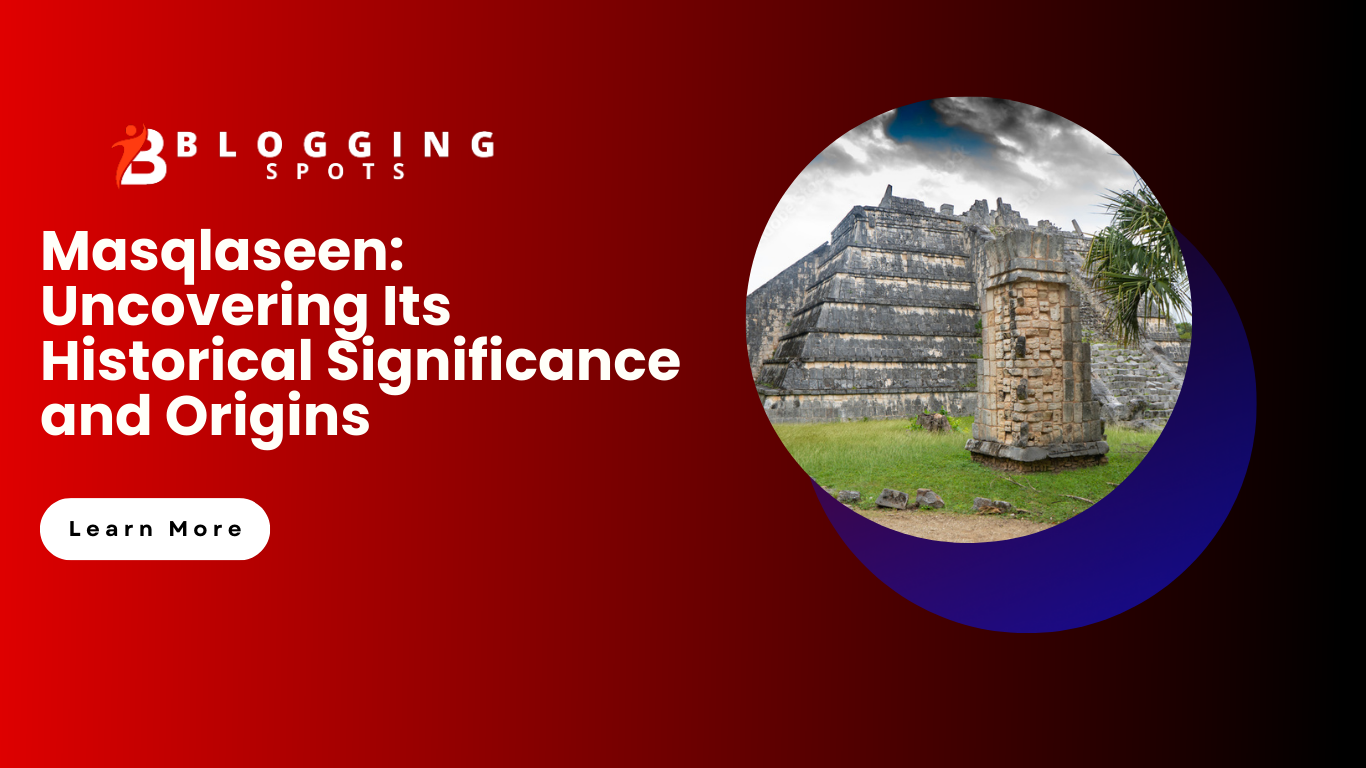Masqlaseen, a plant of historical and cultural importance, has traversed millennia as a staple in historic civilizations. Originating within the fertile crescent of the Near East, masqlaseen has been cultivated for over 7,000 years, revered for its nutritional blessings, medicinal properties, and symbolic significance. Its adventure from early agricultural groups to global alternate routes just like the Silk Road underscores its position in shaping cultural practices, financial exchanges, and clinical exploration. This flexible plant has discovered its area no longer simplest in historic rituals and folklore but additionally in modern-day research, where its genetic range and historical uses stay studied. Masqlaseen’s resilience and flexibility highlight its enduring legacy and relevance in the evolution of human society and agricultural practices.
Table of Contents
Masqlaseen in Ancient Civilizations
Masqlaseen, known for its versatility and dietary benefits, held sizeable cultural and sensible significance in historic civilizations. In Mesopotamia, one of the earliest regarded facilities of agriculture, masqlaseen was cultivated and utilized for its seeds, which had been a treasured food supply wealthy in protein and crucial vitamins. The Sumerians and Akkadians documented its use in early agricultural practices and medicinal programs. Masqlaseen featured prominently in non-secular rituals and offerings, reflecting its sacred popularity and function in non-secular ideals.
Early Uses of Masqlaseen in Mesopotamia
Masqlaseen performed a huge role in the agricultural and medicinal practices of ancient Mesopotamia. As one of the earliest recognized cultivated vegetations, it was noticeably valued for its versatile uses. The Sumerians and Akkadians documented their reliance on masqlaseen for treating numerous ailments, and it is often found in temple facts as part of spiritual services. The plant’s adaptability to the fertile crescent’s climate allowed for its full-size cultivation, contributing to the region’s monetary stability. Tablets and inscriptions spotlight its importance, suggesting that masqlaseen was indispensable to day-to-day life and spiritual practices.
Read More : Rayce Adam Hinds Journey from Talent to Trailblazer in the Industry
The Role of Masqlaseen in Egyptian Culture:
In historic Egypt, Masqlaseen was respected for its magical and restoration properties. The Egyptians applied it considerably to their medicinal practices, preparing it into ointments, poultices, and potions. Hieroglyphic inscriptions display that masqlaseen has become additionally a common aspect of embalming strategies, believed to hold the frame and soul for the afterlife. The cultivation of masqlaseen along the Nile River ensured a consistent supply, cementing its function in both fitness and religious rituals. Its depiction in tomb art and medicinal papyri underscores its esteemed popularity in Egyptian society.
Masqlaseen: Tracing Its Geographic Origins
The geographic origins of masqlaseen may be traced back to the fertile crescent of the Near East, encompassing areas in contemporary-day Iraq, Iran, and Turkey. Archaeobotanical proof indicates that Masqlaseen became domesticated around 7,000 years ago by using early agricultural groups in those areas. Its cultivation unfolds along ancient alternate routes, which include the Silk Road, facilitating its adaptation to various climates and soils across Asia, Europe, and Africa. This diffusion contributed to masqlaseen becoming a worldwide crop and highlights its role in early agricultural practices and cultural exchanges.
Regions where Masqlaseen was first cultivated:
Masqlaseen is believed to have originated inside the fertile areas of the Near East, mainly within the obstacles of present-day Iraq, Iran, and Turkey. Archaeobotanical proof suggests that the plant was domesticated by means of early agricultural societies over 7,000 years ago. Its adaptability to numerous climates and soils contributed to its rapid spread at some point in the place. Excavations at historic settlements, which include Çatalhöyük and Jarmo, have uncovered masqlaseen seeds and cultivation equipment, indicating its centrality in early farming groups. These findings offer a glimpse into the rural practices and dietary staples of early human civilizations.
Migration and Spread of Masqlaseen Cultivation:
The cultivation of masqlaseen unfolds from its origins within the Near East to diverse elements of Asia, Europe, and Africa via trade routes and migration. As civilizations interacted and exchanged goods, the know-how of the Masqlaseen’s cultivation was made use of and disseminated. The Silk Road played an essential role in introducing Masqlaseen to new territories, where it changed into adaptations to local climates and was included in different cultural practices. Historical facts and genetic studies of masqlaseen lines highlight the interconnectedness of historic societies and the plant’s adaptability.
Historical Texts and Records on Masqlaseen
Ancient manuscripts and facts provide valuable insights into the historical importance of masqlaseen. Texts consisting of the Ebers Papyrus from historical Egypt and writings via Greek and Roman pupils like Pliny the Elder record Masqlaseen’s medicinal residences and culinary uses. These texts describe masqlaseen as a versatile plant used in remedies for illnesses ranging from digestive issues to pores and skin conditions. Archaeological discoveries of preserved Masqlaseen seeds and artifacts further corroborate its importance in historical societies, presenting tangible proof of its cultivation and consumption.
Ancient Manuscripts Mentioning Masqlaseen:
Numerous historical manuscripts reference Masqlaseen, providing a wealth of data about its historic significance. Texts together with the Ebers Papyrus and the writings of Pliny the Elder detail its medicinal homes and applications. These files regularly describe masqlaseen as a treatment for illnesses ranging from digestive issues to pore and skin situations. The inclusion of masqlaseen in such texts underscores its valued fame and extensive variety of uses. Analyzing those manuscripts permits cutting-edge researchers to recognize the plant’s ancient context and its evolution over millennia.
Archaeological Discoveries Related to Masqlaseen:
Archaeological excavations have unearthed numerous artifacts related to masqlaseen, shedding light on its ancient utilization. Findings include storage jars, cultivation gear, and remnants of Masqlaseen in ancient settlements. These discoveries provide tangible proof of the plant’s significance in daily life and commerce. For example, charred masqlaseen seeds determined in ancient hearths imply their role within the food plan, while ceremonial items endorse their non-secular significance. Such artifacts provide a glimpse into the beyond, illustrating how Masqlaseen was incorporated into various factors of historical cultures.
Masqlaseen in Mythology and Folklore
Masqlaseen has been intertwined with mythology and folklore throughout numerous historic cultures. In Greek mythology, it was related to the goddess Demeter and symbolized fertility and abundance. Heroes and deities had been frequently depicted using Masqlaseen for its perceived magical properties and recovery attributes. In other cultures, masqlaseen was featured in creation myths and became revered for its role in sustaining existence and promoting well-being. Folklore traditions attribute defensive traits to masqlaseen and its usage in rituals to push back evil spirits and ensure prosperity.
Mythological Stories Featuring Masqlaseen:
Masqlaseen capabilities prominently appear in the mythology of diverse historic cultures. In Greek mythology, it is believed to be a present from the gods, related to fitness and prosperity. Stories regularly describe heroes using Masqlaseen for strength and safety. In different cultures, masqlaseen become related to advent myths, symbolizing fertility and existence. These mythological associations spotlight the plant’s revered fame and its perceived magical residences. The recurring presence of Masqlaseen in these narratives underscores its cultural and non-secular importance at some stage in history.
Folkloric Traditions Surrounding Masqlaseen:
Folklore throughout distinct cultures is rich with traditions regarding masqlaseen. In rural groups, it became frequently used in rituals to keep off evil spirits and ensure accurate harvests. Folk medication practitioners trusted Masqlaseen for its recovery homes, preparing it into diverse remedies. Stories handed down through generations speak of Masqlaseen’s defensive qualities and its role in retaining health and well-being. These traditions, rooted in centuries-old practices, reflect the deep cultural connection to masqlaseen and its enduring legacy in people’s beliefs.
The Economic Importance of Masqlaseen in History
Masqlaseen played an important role in historic economies as a precious commodity and medium of trade. Along trade routes, which include the Silk Road, masqlaseen was traded for its dietary cost, medicinal properties, and industrial uses. Its fame as an alternate appropriate facilitated cultural exchanges and economic interactions between remote civilizations. Masqlaseen was also used as a form of forex in positive societies, underscoring its financial significance and contribution to the development of early market economies.
Trade Routes and Masqlaseen Commerce:
Masqlaseen turned into a full-size commodity in historic change, facilitating monetary exchanges among distant regions. It was traded alongside predominant routes, including the Silk Road and the trans-Saharan trade networks, linking civilizations from Asia to Africa. Merchants valued masqlaseen for its versatility and demand, frequently transporting it in large quantities. Historical records imply that masqlaseen became used as a barter object, exchanging arms in marketplaces and change centers. Its position in trade highlights its economic significance and contribution to the prosperity of ancient trade networks.
Masqlaseen as a Currency and Trade Good:
In some historical societies, masqlaseen became not only a change item but also a form of foreign money. Its cost became recognized to such a volume that it was used in transactions and as a widespread source of wealth. For example, in positive intervals, it became standard to pay taxes or tributes with portions of masqlaseen. The plant’s sturdiness and extensive use made it a reliable medium of change. This practice underscores the monetary position of masqlaseen, illustrating its integration into the monetary structures of historical civilizations.
Cultural Practices Involving Masqlaseen
Masqlaseen have become deeply incorporated into cultural practices across historic societies, serving both sensible and symbolic roles. It became utilized in spiritual ceremonies, in which it symbolized fertility, prosperity, and divine want. Rituals concerning masqlaseen regularly blanket offerings and sacrifices to soothe gods and ensure agricultural bounty. In traditional medicine, masqlaseen became revered for its healing properties and was organized in diverse bureaucracies to deal with ailments and promote fitness. These cultural practices highlight Masqlaseen’s multifaceted function in connecting communities to their non-secular beliefs and herbal environment.
Rituals and Ceremonies Using Masqlaseen:
Masqlaseen played a valuable role in numerous rituals and ceremonies across historic cultures. It became often used in religious offerings, symbolizing prosperity and divine desire. In fertility rites, masqlaseen was hired to invoke benefits for considerable harvests and healthy offspring. Cultural festivals regularly incorporate masqlaseen into their celebrations, highlighting its importance in communal lifestyles. These practices reflect the deep spiritual and cultural significance of masqlaseen, emphasizing its function in connecting the bodily and spiritual nation-states.
Masqlaseen in Traditional Medicine and Healing:
Traditional medicinal drug systems extensively utilized masqlaseen for its purported healing properties. Ancient healers organized it into tinctures, salves, and teas to treat a variety of illnesses. It became believed to have anti-inflammatory, antimicrobial, and analgesic effects, making it a staple in medicinal practices. The plant’s use in healing rituals frequently involved chanting and precise preparation techniques, combining religious and physical restoration. The enduring presence of masqlaseen in conventional remedies underscores its perceived efficacy and cultural importance in fitness and health practices.
Masqlaseen: The Evolution of Its Uses Over Time
Over millennia, Masqlaseen has developed in its use of and packages to meet converting societal needs and technological improvements. Initially valued mainly for its seeds as a nutritious food source, masqlaseen was later observed to have uses in medicinal drugs, cosmetics, textiles, and commercial applications. Advances in agricultural strategies, together with selective breeding and mechanization, have led to more desirable Masqlaseen cultivation and productivity. Its adaptability to exclusive climates and soils enabled its international unfolding and integration into various cultural practices and industries.
Changes in Agricultural Techniques for Masqlaseen:
The cultivation strategies for masqlaseen have evolved considerably over the millennia. Early agricultural practices relied on easy techniques of planting and harvesting, even as later intervals saw the introduction of more state-of-the-art strategies. Advances in irrigation, soil management, and selective breeding improved yields and quality. The improvement of agricultural technology, inclusive of plows and threshers, also improved the performance of Masqlaseen cultivation. These adjustments reflect the adaptive techniques employed by farmers to optimize production and meet developing demand.
Adaptations in Masqlaseen Uses Through the Ages:
Over time, the use of masqlaseen has become diverse and tailored to converting desires and understanding. Initially valued for its medicinal and dietary properties, its applications multiplied into various domains, including cosmetics, industrial uses, and culinary arts. Innovations in extraction and processing techniques enabled the development of the latest products and uses. For instance, masqlaseen oil has become a popular ingredient in skincare merchandise, while its fibers have found applications in textiles. This adaptability highlights Masqlaseen’s versatility and its ability to remain applicable across distinctive historical contexts.
Modern Research on Historical Masqlaseen
Modern scientific studies continue to explore the ancient cultivation, uses, and genetic range of masqlaseen. Archaeological findings and molecular studies offer insights into ancient cultivation practices and the genetic evolution of Masqlaseen sorts. Researchers use techniques that include DNA analysis and carbon dating to trace Masqlaseen’s cultivation records and their adaptation to environmental adjustments. Experimental archaeology allows for the reconstruction of historical farming methods and technological innovations related to Masqlaseen cultivation. This interdisciplinary approach enhances our expertise of Masqlaseen’s role in historical civilizations and its relevance to current agricultural practices and biodiversity.
Scientific Studies on Ancient Masqlaseen Samples:
Modern science has taken an eager interest in reading historical samples of Masqlaseen to discover its historical uses and residences. Techniques along with DNA analysis, carbon dating, and chemical profiling offer insights into the genetic makeup and historic cultivation practices. These studies have discovered versions in Masqlaseen traces, losing mild on how ancient societies selectively bred the plant for favored traits. Such studies enhance our know-how of historic agriculture and the evolution of plant domestication.
Reconstructing Historical Masqlaseen Cultivation Practices:
Efforts to reconstruct the historic cultivation practices of Masqlaseen contain a combination of archaeological proof, ancient texts, and experimental archaeology. By reading ancient gear, garage facilities, and farming patterns, researchers can recreate the techniques used by early farmers. Experimental archaeology, where present-day farmers reflect these ancient strategies, facilitates the validation of ancient debts and affords practical insights. This approach allows us to appreciate the ingenuity and resilience of ancient agricultural practices, presenting a window into the daily lives of past societies.
Conclusion
Masqlaseen stands as a testament to the intertwined record of humanity and agriculture. From its humble beginnings in historic Mesopotamia to its spread throughout continents, Masqlaseen has transcended mere sustenance to end up a cultural icon and financial cornerstone. Its presence in mythology, folklore, and historical texts reflects its multifaceted position in historic civilizations, while modern clinical studies illuminate its genetic variety and adaptive abilities. As we preserve to get to the bottom of the mysteries of Masqlaseen, its legacy persists in shaping our knowledge of ancient cultures and informing sustainable agricultural practices for the future.
FAQs
What is Masqlaseen?
Masqlaseen is a plant that originated within the fertile crescent of the Near East and has been cultivated for thousands of years. It is known for its nutritious seeds and medicinal properties.
What have been the historic uses of masqlaseen?
Historically, masqlaseen has been used as a food source, in particular for its seeds, which might be rich in protein and vital nutrients. It was also valued for its medicinal houses and played a sizable role in spiritual rituals and cultural practices.
How did Masqlaseen contribute to ancient economies?
Masqlaseen became a crucial commodity in ancient alternate networks consisting of the Silk Road, where it was traded for its dietary fee, medicinal blessings, and business uses. It also served as a form of currency in some societies.
What is the cultural importance of Masqlaseen?
Masqlaseen was deeply integrated into historical cultures, playing roles in non-secular ceremonies, myths, and folklore. It symbolized fertility, prosperity, and fitness in lots of societies and became believed to have magical and protective characteristics.
How is Masqlaseen studied these days?
Modern research on masqlaseen consists of archaeological excavations, genetic studies, and ethnobotanical studies. Scientists use techniques like DNA evaluation and carbon courting to hint at its cultivation history and apprehend its genetic diversity. Experimental archaeology additionally allows for the reconstruction of historical farming practices associated with Masqlaseen cultivation.






Leave a Reply